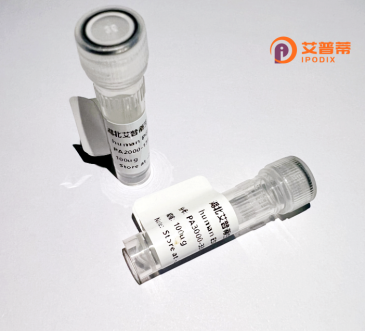
| 纯度 | >90%SDS-PAGE. |
| 种属 | Human |
| 靶点 | DPM1 |
| Uniprot No | O60762 |
| 内毒素 | < 0.01EU/μg |
| 表达宿主 | E.coli |
| 表达区间 | 1-260aa |
| 氨基酸序列 | MASLEVSRGPRRSRRELEVRSPRQNKYSVLLPTYNERENLPLIVWLLVKSFSESGINYEIIIIDDGSPDGTRDVAEQLEKIYGSDRILLRPREKKLGLGTAYIHGMKHATGNYIIIMDADLSHHPKFIPEFIRKQKEGNFDIVSGTRYKGNGGVYGWDLKRKIISRGANFLTQILLRPGASDLTGSFRLYRKEVLEKLIEKCVSKGYVFQMEMIVRARQMNYTIGEVPISFVDRVYGESKLGGNEIVSFLKGLLTLFATT |
| 分子量 | 56 kDa |
| 蛋白标签 | GST-tag at N-terminal |
| 缓冲液 | 0 |
| 稳定性 & 储存条件 | Lyophilized protein should be stored at ≤ -20°C, stable for one year after receipt. Reconstituted protein solution can be stored at 2-8°C for 2-7 days. Aliquots of reconstituted samples are stable at ≤ -20°C for 3 months. |
| 复溶 | Always centrifuge tubes before opening.Do not mix by vortex or pipetting. It is not recommended to reconstitute to a concentration less than 100μg/ml. Dissolve the lyophilized protein in distilled water. Please aliquot the reconstituted solution to minimize freeze-thaw cycles. |
以下是关于重组人DPM1蛋白的3篇文献摘要信息,供参考:
1. **文献名称**:*Molecular cloning and functional expression of human dolichol-phosphate mannose synthase*
**作者**:Tomita, Y., et al. (1998)
**摘要**:该研究首次克隆了人DPM1基因,并在哺乳动物细胞中重组表达,证明其编码的蛋白为Dolichol-phosphate mannose合成酶的核心催化亚基。进一步实验表明,单独的DPM1缺乏酶活性,需与辅助亚基DPM2结合形成复合物才能发挥功能。
2. **文献名称**:*DPM2 regulates biosynthesis of dolichol-phosphate-mannose in a DPM1-dependent manner*
**作者**:Maeda, Y., et al. (2000)
**摘要**:本文通过在大肠杆菌中共表达人源DPM1和DPM2蛋白,解析了两者的相互作用机制。研究发现DPM2通过稳定DPM1的构象,促进其在内质网膜上的定位,从而有效合成Dolichol-phosphate-mannose(DPM),揭示了二者在糖基化中的协同作用。
3. **文献名称**:*Structural basis of dolichyl phosphate mannose synthesis by the DPM1-DPM2 complex*
**作者**:Hirschi, M., et al. (2021)
**摘要**:该研究利用冷冻电镜技术解析了人源DPM1-DPM2复合物的三维结构,阐明其催化DPM合成的分子机制。通过重组表达蛋白,验证了关键氨基酸突变对酶活性的影响,为先天性糖基化障碍(CDG)相关突变提供了分子层面的解释。
---
**提示**:若需扩展阅读,可关注DPM1在**先天性糖基化障碍(CDG)**中的病理机制或其在**真核表达系统优化**中的研究进展。
Recombinant human DPM1 (dolichyl-phosphate mannosyltransferase subunit 1) protein is a key enzyme involved in the N-linked glycosylation pathway, a critical post-translational modification process essential for protein folding, stability, and cellular recognition. DPM1 catalyzes the transfer of mannose from GDP-mannose to dolichyl phosphate, forming dolichyl-phosphate-mannose (Dol-P-Man), a lipid-linked sugar donor required for synthesizing glycan precursors in the endoplasmic reticulum.
DPM1 functions as part of a multi-subunit complex, requiring interaction with regulatory subunits like DPM2 and DPM3 for stability and enzymatic activity. Mutations in the DPM1 gene are linked to congenital disorders of glycosylation (CDGs), specifically CDG-Ie, characterized by neurological deficits, developmental delays, and multisystem abnormalities.
The recombinant form of DPM1 is produced using heterologous expression systems (e.g., E. coli, mammalian cells) to study its biochemical properties, structural interactions, and role in disease mechanisms. It serves as a vital tool for elucidating glycosylation pathways, screening therapeutic agents, and developing enzyme replacement strategies. Research on recombinant DPM1 also contributes to understanding broader cellular processes, including ER stress and protein quality control, offering insights into therapeutic interventions for glycosylation-related diseases.
×